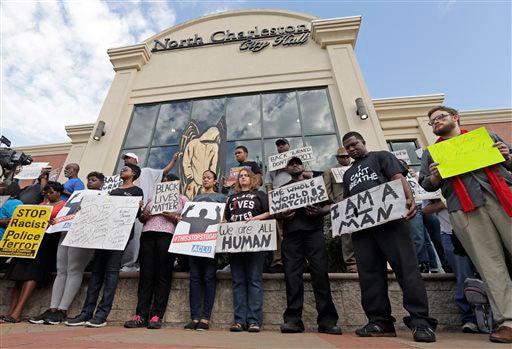|
April 10, 2015
Video suggests police shooting in South Carolina not justified, Stanford legal expert says
Stanford law Professor David Sklansky said the police shooting in South Carolina of a man fleeing from an officer appears to have not been justified, based on the video taken by a bystander. He suggests body cameras for officers, greater law enforcement diversity, and fair and objective investigations when the police use lethal force. By Clifton B. Parker

Demonstrators pause for a moment of silence on April 8, 2015, at city hall in North Charleston, South Carolina, to protest the shooting death of Walter Scott. Stanford law Professor David Sklansky said the shooting of Scott by police officer Michael Slager appears to have not been justified. (AP Photo/Chuck Burton)
Judging from the video footage that has dominated news coverage around the country, the police shooting in South Carolina of a black man running away from a white officer likely did not meet legal tests for such force, a Stanford criminal law expert said.
David A. Sklansky, a Stanford professor of law and a former federal prosecutor, has written extensively on police reform, democracy and law enforcement, and the future of policing.
Stanford News Service recently interviewed Sklansky on the legalities surrounding the death of the South Carolina man, Walter Scott, who was shot in the back by police officer Michael Slager. In a video, Slager is seen firing eight times as Scott is fleeing.
Did the shooting in South Carolina meet a legal test?
Federal constitutional law allows a police officer to shoot a fleeing suspect only when there are grounds for thinking the suspect is violent and dangerous. Nothing in the video or in the news reports about Walter Scott's arrest suggests that this was the case. Videos don't necessarily tell the whole story, of course, and Michael Slager, like anyone else accused of a crime, is entitled to the presumption of innocence. But the video looks very bad.
What are the factors that go into a justified police shooting? When can the police use force?
The rules vary somewhat based on state law and local police regulations, but the floor is set by the federal Constitution, which allows police to use only "reasonable" force. The Supreme Court ruled 30 years ago that it's not reasonable for the police to use lethal force to stop a fleeing suspect unless there's probable cause to believe that the suspect poses a threat of serious bodily harm to the officer or to others. And even then the officer has to give a warning first, if that's feasible.
Does this type of incident happen a lot more often than society is aware?
It's hard to know. It's certainly true that cellphones are providing us with video records of encounters that a few decades ago would have come down to the word of the officer versus the word of the suspect – or, if the suspect was killed, the word of the officer alone.
What is the current situation regarding police misconduct in the United States?
Policing in the United States has improved dramatically over the past few decades. Most police officers in this country are conscientious and professional. But, yes, police misconduct remains a serious problem, and it is one that departments and localities around the country still struggle to address. Rates of police violence have dropped, but they are still higher than we should want them to be. And the victims of abusive policing tend disproportionately to be African American or Latino.
What types of measures could be adopted that could help prevent such police shootings?
The preliminary evidence from police departments that have adopted body cameras suggests that they significantly reduce the use of force by the police and also the number of citizen complaints. Better screening and training can help, as well.
It is also important for police shootings to be investigated and evaluated in ways that are objective, fair and as transparent as possible. It is encouraging, in this regard, that the shooting of Walter Scott is being investigated by state rather than local authorities.
It's critical, too, that we continue to diversify the workforces of American police departments. It's not clear how much, if at all, the race and gender of an individual officer matters in determining how the officer acts, but diverse departments do seem to be less insular, more open to reform, and better at enlisting the trust and cooperation of minority communities.
-30-
|